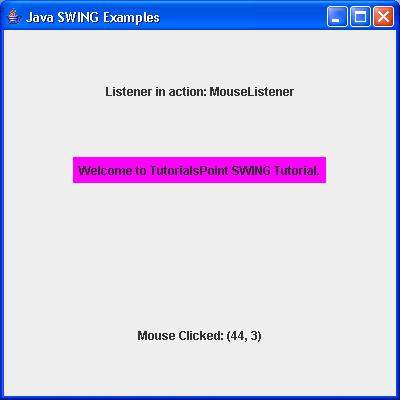
- SWING Tutorial
- SWING - Home
- SWING - Overview
- SWING - Environment
- SWING - Controls
- SWING - Event Handling
- SWING - Event Classes
- SWING - Event Listeners
- SWING - Event Adapters
- SWING - Layouts
- SWING - Menu
- SWING - Containers
- SWING Useful Resources
- SWING - Quick Guide
- SWING - Useful Resources
- SWING - Discussion
SWING - MouseListener Interface
The class which processes the MouseEvent should implement this interface. The object of that class must be registered with a component. The object can be registered using the addMouseListener() method.
Interface Declaration
Following is the declaration for java.awt.event.MouseListener interface −
public interface MouseListener extends EventListener
Interface Methods
| Sr.No. | Method & Description |
|---|---|
| 1 |
void mouseClicked(MouseEvent e) Invoked when the mouse button has been clicked (pressed and released) on a component. |
| 2 |
void mouseEntered(MouseEvent e) Invoked when the mouse enters a component. |
| 3 |
void mouseExited(MouseEvent e) Invoked when the mouse exits a component. |
| 4 |
void mousePressed(MouseEvent e) Invoked when a mouse button has been pressed on a component. |
| 5 |
void mouseReleased(MouseEvent e) Invoked when a mouse button has been released on a component. |
Methods Inherited
This interface inherits methods from the following interfaces −
java.awt.EventListener
MouseListener Example
Create the following Java program using any editor of your choice in say D:/ > SWING > com > tutorialspoint > gui >
SwingListenerDemo.java
package com.tutorialspoint.gui;
import java.awt.*;
import java.awt.event.*;
import javax.swing.*;
public class SwingListenerDemo {
private JFrame mainFrame;
private JLabel headerLabel;
private JLabel statusLabel;
private JPanel controlPanel;
public SwingListenerDemo(){
prepareGUI();
}
public static void main(String[] args){
SwingListenerDemo swingListenerDemo = new SwingListenerDemo();
swingListenerDemo.showMouseListenerDemo();
}
private void prepareGUI(){
mainFrame = new JFrame("Java SWING Examples");
mainFrame.setSize(400,400);
mainFrame.setLayout(new GridLayout(3, 1));
headerLabel = new JLabel("",JLabel.CENTER );
statusLabel = new JLabel("",JLabel.CENTER);
statusLabel.setSize(350,100);
mainFrame.addWindowListener(new WindowAdapter() {
public void windowClosing(WindowEvent windowEvent){
System.exit(0);
}
});
controlPanel = new JPanel();
controlPanel.setLayout(new FlowLayout());
mainFrame.add(headerLabel);
mainFrame.add(controlPanel);
mainFrame.add(statusLabel);
mainFrame.setVisible(true);
}
private void showMouseListenerDemo(){
headerLabel.setText("Listener in action: MouseListener");
JPanel panel = new JPanel();
panel.setBackground(Color.magenta);
panel.setLayout(new FlowLayout());
panel.addMouseListener(new CustomMouseListener());
JLabel msglabel =
new JLabel("Welcome to TutorialsPoint SWING Tutorial.",JLabel.CENTER);
panel.add(msglabel);
msglabel.addMouseListener(new CustomMouseListener());
panel.add(msglabel);
controlPanel.add(panel);
mainFrame.setVisible(true);
}
class CustomMouseListener implements MouseListener {
public void mouseClicked(MouseEvent e) {
statusLabel.setText("Mouse Clicked: ("+e.getX()+", "+e.getY() +")");
}
public void mousePressed(MouseEvent e) {
}
public void mouseReleased(MouseEvent e) {
}
public void mouseEntered(MouseEvent e) {
}
public void mouseExited(MouseEvent e) {
}
}
}
Compile the program using the command prompt. Go to D:/ > SWING and type the following command.
D:\SWING>javac com\tutorialspoint\gui\SwingListenerDemo.java
If no error occurs, it means the compilation is successful. Run the program using the following command.
D:\SWING>java com.tutorialspoint.gui.SwingListenerDemo
Verify the following output.
